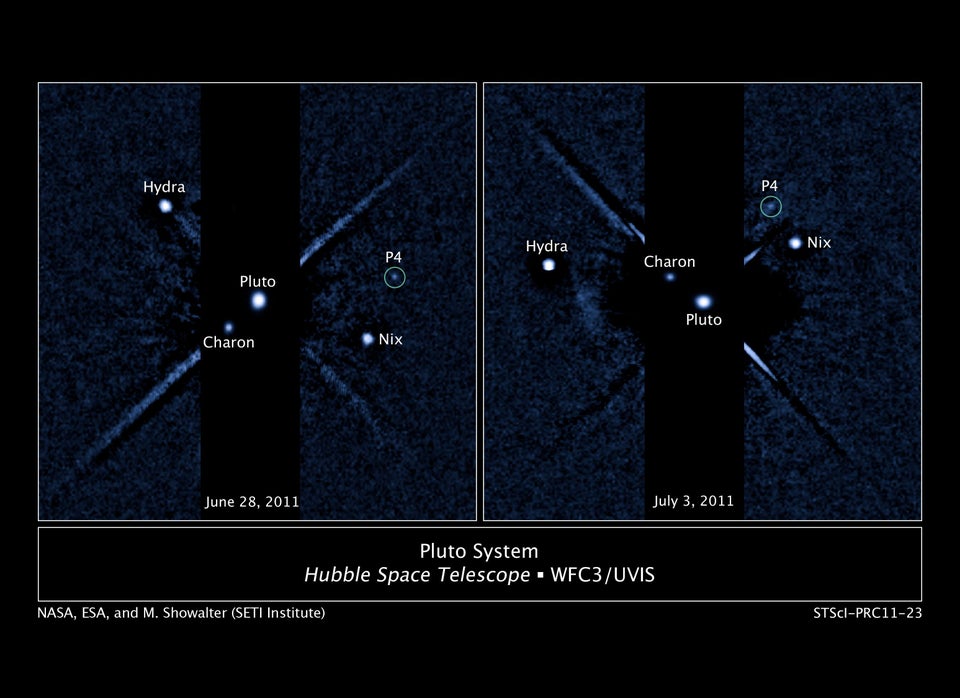
As every astronomy buff knows, dark matter is pretty elusive stuff.
We can't see it. We can't hear it or feel it, and we certainly can't smell or taste it. Even with the world's most sophisticated scientific gear, there's no direct proof that the long-hypothesized form of matter exists at all--though the universe is now believed to be full of the stuff.
But if its existence is no longer in doubt, plenty of questions remain about dark matter--including what sorts of particles it's made of. And along with other leading scientists, Harvard physicist Lisa Randall (above) is trying to answer those questions.
Recently, HuffPost senior science editor David Freeman caught up with Randall, who has penned a provocative new book entitled "Dark Matter and the Dinosaurs," and asked a few questions via email aimed at shedding more light on this fascinating topic:
What is dark matter?
It's an elusive form of matter that interacts through gravity like ordinary matter but that doesn't emit or absorb light. Dark matter seems to exist throughout the universe. But we don't perceive it directly--only through its gravitational influence--because it interacts so feebly with the ordinary matter that we're all familiar with.
Is dark matter made of atoms?
No. It's not composed of atoms or the familiar elementary particles such as protons and electrons that are charged and therefore do interact with light. But it may be that dark matter is composed of particles whose mass is comparable to those we know. If that's the case, and if those particles travel at the velocities we expect, billions of dark matter particles pass through each of us every second. Yet no one notices that they are there.
If it's invisible, why call it "dark?"
Dark matter might have been better off with the name "transparent matter." The stuff we call "dark" like your black shirt or jacket absorbs light. With dark matter, light just passes through.
How can we tell dark matter exists?
We know it's there because we can see its effect on stars and galaxies. That is, with the help of telescopes and other instruments, we can see that something beyond the gravity of the stars and galaxies we can observe is affecting the movements of those stars and galaxies.
Dark matter affects the expansion of the universe, the path of light rays reaching us from distant objects, the orbits of stars around the centers of galaxies, and many other measurable phenomena in ways that convince us of its existence. We know about dark matter--and indeed it does exist--because of these measurable gravitational effects.
Dark matter was first hypothesized many decades ago. Tell us about that.
Dark matter was first hypothesized in 1933 by Fritz Zwicky, a Swiss astronomer working at Caltech. He came up with the idea after observing the velocities of stars in a gigantic group of gravitationally connected galaxies known as the Coma Cluster. It takes a certain amount of gravity to keep the fast-moving stars in a cluster from flying apart from one another. And based on his measurements of the velocity of the stars, Zwicky calculated that the amount of mass required for the cluster to have sufficient gravitational pull was 400 times greater than the contribution of the measured luminous mass--the matter that emits light. To account for all that extra matter, Zwicky proposed the existence of what he named dunkle materie, which is German for dark matter.
Despite these early observations, dark matter for a long time was essentially ignored (and his estimate of the missing matter was in fact too big). However, the idea was resurrected in the 1970s, when astronomers observed the motion of satellite galaxies--small galaxies in the vicinity of larger ones--that could be explained only by the presence of additional, unseen matter. These and other observations began to turn dark matter into a topic of serious inquiry.
But its status was truly solidified in the 1970s by the work of Vera Rubin, an astronomer at the Carnegie Institution of Washington. Rubin and her collaborator Kent Ford found that the rotational velocities of stars were pretty much the same at any distance from the galactic center. That is, stars rotated with constant velocity, even well beyond the region containing luminous matter. The only possible explanation was some as-yet-unaccounted-for matter that helps rein in the farther-out stars, which moved far more quickly than expected.
These researchers' remarkable deduction was that ordinary matter accounted for only about a sixth of the mass that was required to keep them in orbit. Their observations yielded the strongest evidence at the time for dark matter.
What is the current state of knowledge about dark matter?
Scientists have made a great deal of progress in understanding dark matter, yet big questions remain. For a researcher like me, this is the optimal situation. Perhaps one can say that physicists studying "the dark" are participating in a Copernican revolution in a more abstract form. Not only is the Earth not physically the center of the universe, but our physical makeup is not central to most of its matter.
Discerning the most basic elements of ordinary matter was challenging, but its study has been far more straightforward than investigating the dark matter that is all around us. Despite the weakness of its interactions, scientists have a real chance in the coming decade of identifying and deducing the nature of dark matter. And because dark matter clusters into galaxies and other structures, upcoming observations of the galaxy and the universe will allow physicists and astronomers to measure it in newer ways.
Do new findings about dark matter tell us anything about the origins of the universe?
No one knows how the universe began, and knowing about dark matter doesn't necessarily bring us new insights. But certainly the existence of dark matter helps us understand how the universe developed and how structures such as galaxies formed. If dark matter has peculiar properties, it might be reflected in galaxy sizes and distributions.
How about the existence of multiple universes--the so-called multiverse?
Dark matter and multiple universes are really unrelated. We know about dark matter because of its effects on our universe's expansion, among other things. Other universes might have even darker matter in the sense that they are so distant they can't even affect us gravitationally any time in the lifetime of the universe. But that also means we can't study them with observations. I state in my book that I prefer to study the "multiverse" of matter that is right here.
Speaking of your book, what is the connection between dark matter and the dinosaurs?
My collaborators and I suggest that dark matter might ultimately (and indirectly) have been responsible for the extinction of the dinosaurs. We know that 66 million years ago, an object at least 10 kilometers wide plummeted to Earth from space and destroyed the terrestrial dinosaurs, along with three-quarters of the other species on the planet. The object might have been a comet from the so-called Oort belt, a region of comets and debris beyond the orbit of Neptune. But as to why this comet (if that's what it was) was perturbed from its stable orbit in the Oort belt, no one knows for sure.
Our proposal is that during the solar system's passage through the midplane of our Milky Way galaxy, it encountered a disk of dark matter that dislodged the distant object, thereby precipitating this cataclysmic impact. In our galactic vicinity, the bulk of the dark matter surrounds us in an enormous smooth and diffuse spherical halo.
(Story continues below illustration.)

The type of dark matter that triggered the dinosaurs' demise would be distributed very differently from most of the dark matter in the universe. The additional type of dark matter would leave the halo intact, but its very different interactions would make it condense into a disk--right in the middle of the Milky Way plane. This thin region could be so dense that when the solar system passes through it, as the sun oscillates up and down during its orbit through our galaxy, the disk's gravitational influence would be unusually strong.
Its gravitational pull could be powerful enough to dislodge comets at the outer edge of the solar system, where the sun's competing pull would be too weak to rein them back in. The errant comets would then be ejected from the solar system or--more momentously--be redirected to hurtle toward the inner solar system, where they might have the potential to strike the Earth.
If dark matter might explain the demise of the dinosaurs, might it also explain how life on Earth got its start?
Stuff hitting the Earth such as comets and asteroids almost certainly played a role in determining the Earth's composition and might have even played a role in triggering life or some key processes that were essential to it. Most of these are speculative, but they are fascinating and well worth pursuing.
So if dark matter can send dangerous comets and asteroids our way, should we be worried?
Clearly, asteroids sometimes come close. Encounters will undoubtedly occur, but their expected frequency and magnitude remain subjects of debate. Whether or not something will hit and do damage on time scales that we should care about is not yet an entirely settled question. I personally don't think they are the greatest danger to humanity.
Should we worry? It's all a matter of scale, cost, our anxiety threshold, the decisions societies make about what is important, and what we think we can control. Such threats are not overly pressing, even if some potential damage is possible. Though it's possible that an infelicitously directed one could hit and wipe out a major population center, the odds of that happening anytime in the foreseeable future are extremely remote. The ultimate issues for society, as with all scientific and engineering efforts, are what we value, what we learn, and what the ancillary benefits might be.
As a physicist, your view of the cosmos differs from that of nonscientists. What misconceptions do nonscientists have regarding the universe?
There are many but let me focus on dark matter itself. Given that they've never seen (or felt or smelled) it, many people I've spoken to are surprised at the existence of dark matter and find it quite mysterious--or even wonder if it's some sort of mistake. People ask how it can possibly be that most matter--about five times the amount of ordinary matter--cannot be detected with conventional telescopes.
Personally, I would expect quite the opposite (though admittedly not everyone sees it this way). It would be even more mysterious to me if the matter we can see with our eyes were all the matter that exists. Why should we have perfect senses that can directly perceive everything? The big lesson of physics over the centuries is how much is hidden from our view. From this perspective, the question is really why the stuff we do know about should constitute as much of the energy density of the Universe as it does.
Do you feel a sense of awe about the universe? Or does your scientific knowledge get in the way?
When I started concentrating on the concepts underlying the ideas in my book, I was awestruck and enchanted not only by our current knowledge of our environment--local, solar, galactic, and universal--but also by how much we ultimately hope to understand, from our random tiny perch here on Earth. I also was overwhelmed by the many connections among the phenomena that ultimately allow us to exist.
To be clear, mine is not a religious viewpoint. I don't feel the need to assign a purpose or meaning. Yet I can't help but feel the emotions we tend to call religious as we come to understand the immensity of the universe, our past, and how it all fits together. It offers anyone some perspective when dealing with the foolishness of everyday life. This newer research actually has made me look differently at the world and the many pieces of the universe that created the Earth--and us.
CORRECTION: An earlier version of this article mistakenly gave Fritz Zwicky's first name as Franz.

